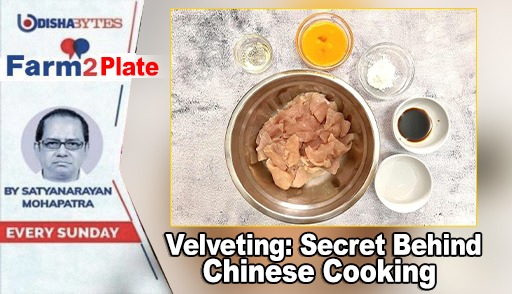Velveting: Secret Behind Chinese Cooking

When I take any meal in my favourite Chinese restaurant — egg, vegetable, chicken, lamb dishes — the texture is out of the world.
This process is known as velveting and in Mandarin, it’s ‘guoyou’ — meaning passing through oil. Right cut of meat pieces are tossed in a batter made from corn starch, egg white, salt, and sometimes Shaoxing or Chinese Yellow Wine and oil — some cooks add a little baking soda as well — and allowed to sit in the fridge for an hour or more, during which time the starch hydrates and the batter adheres to the meat. The coated pieces of meat get a quick bath in 138°C to 150°C oil for 30 seconds, the batter is set and the meat is cooked.
Velveting starts with making a slurry: For 1 pound thinly-sliced meat or alternative protein (it can be anything from chicken, pork, beef, shrimp, tofu, or even mushrooms), combine 1 Tbsp corn starch, 1 Tbsp soy sauce, and 1 Tbsp vegetable or light sesame oil. I like to add sliced onions or garlic as well, which gives the alliums additional time to soak up the oil and salt. Mix everything well, cover, and refrigerate for at least 30 minutes or up to one hour to allow time for the corn starch to transform into a thin gelatinous layer. To give your velveted meat an even thicker coating of the mix, add an egg white to the slurry. Increasing the corn starch and one will end up with something thicker and more substantive, which is better-suited to a stew or soup.
Velveting does more than tenderise your glistening orange chicken — it creates an even protective coating that browns meat more evenly, seals in its juices, and improves overall sauce adhesion. For additional flavour, add oyster sauce, Worcestershire sauce, or even ponzu (a classic Japanese condiment, ponzu sauce is a citrus-based sauce with a tart-tangy flavour similar to vinaigrette which contains a mix of ponzu-citrus juice of sudachi, yuzu, and kabosu and vinegar) — soy sauce, sugar or mirin, and dashi, for a light citrus twist.
Other velveting variations: Instead of oil, the blanching step can also be done in boiling water, sometimes with a splash of oil added to the water. Guoshui, the Chinese term for this technique, means passing through water. Water velveting makes the chicken tender and softer. At home this is the most preferred way which can be adopted.
Omitting the egg white from the batter produces a thinner, slicker final coating on the meat but accomplishes the same essential purpose though this has a different name – slippery coating.
The easiest method of all: Toss the meat in the corn starch batter, and skip the oil or water-based blanching step entirely. Just coat and cook. It provides some benefits, but nothing like the silken, soft texture that true velveting can achieve.
The culinary science behind velveting: Velveting, like many traditional techniques, can be considered as a holistic procedure, but it does have several simultaneous phenomena that produce its unique textural effect.
* Soaking in the batter, especially overnight, chemically tenderises the protein structure of the meat: The alkalinity of both the egg white and the optional baking soda keep the muscle proteins from squeezing together when they’re cooked, thus maintaining a more tender and juicy final product. Salt also improves the moisture retention of the meat—and seasons it.
* The lightly-cooked layer of batter has a slippery texture, making the meat feel more succulent and satiny in the mouth. If it’s oil-velveted, or if oil is added to the water for water-velveting, that fat adds to the sleekness of the texture.
* The layer of batter around the meat insulates it from the high heat of the wok. That means the thin pieces, which would easily overcook and dry out if not protected, remain supple.
* Finally, the meat isn’t at risk for overcooking. Because the meat has already been poached in oil or water before it goes into the wok, it doesn’t need to spend a long time in the wok to cook through, so it can be cooked gently and briefly and come out perfect.
Is Velveting healthy: The main components in the velveting chicken are corn starch and oil, both of which are completely safe for consumption, and healthy. Thus, velveting can provide succulent, soft meat without compromising taste or nutritional value. The consensus is that your chicken should marinate in the velveting mixture for at least 30 minutes. This will guarantee that a good coating forms over your chicken, sealing all those fluids. Thirty minutes should do the work if you’re in a hurry, but you can continue for longer if you want to. Get the marinade going, and then start preparing the other ingredients. That should typically allow the chicken enough time to velvet it fully.
For the road: Marinate the meat or chicken a day before you want to cook it. After preparing the egg white mixture and coating the chicken cubes, store the chicken in a sealed container in the refrigerator until ready to use. Alternatively, add the marinating chicken to freezer bags and store them in the freezer, but only if the chicken you are using is fresh and wasn’t frozen before. Thaw the chicken in the fridge before you want to cook it. When the velvet chicken is through, it is ready to be added to your preferred stir-fry or salad. Even better, you can serve it with a side of salad or over rice. This is a wonderful alternative for entertaining because it will wow your visitors. You can add it to a recipe and savour the lush, tender, and savoury taste when you serve it in a stir-fry.

Comments are closed.